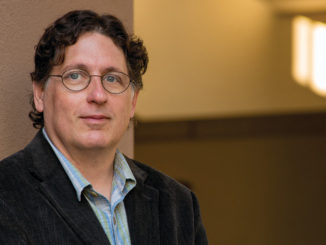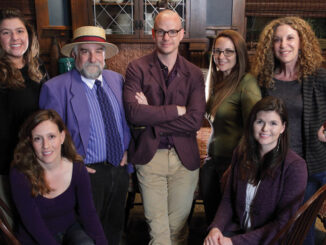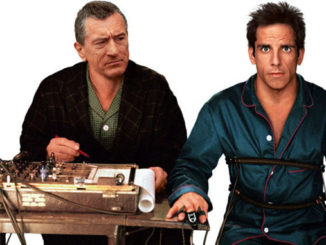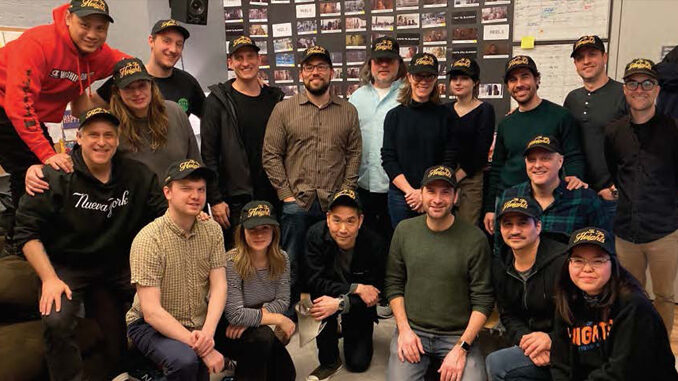
By Patrick Z. McGavin
“It’s almost every editor’s dream to cut a musical,” Myron Kerstein, ACE, said. “I just knew this was my shot, and I would probably never get another one like this in my career. I had to treat every edit as though it had to be perfect.”
Kerstein is the editor of Jon M. Chu’s “In the Heights,” the new film adaptation of the Tony-Award-winning 2008 Broadway musical by “Hamilton” composer and creator Lin-Manuel Miranda.
The story tracks the interlocking fortunes of a group of young people living in the largely Dominican neighborhood of Washington Heights in New York City. The film began streaming on HBO Max in June.
Kerstein told CineMontage about the intense emotional odyssey of bringing the film together and described the collaborative process involved in making it work.
Q You also cut “Crazy Rich Asians” (2018), the previous film by Jon M. Chu. Was your collaboration here a continuation?
Myron Kerstein: I think it was an absolute continuation. To some extent it was like a sequel. The good news is that we developed trust as a shorthand over the course of making “Crazy Rich Asians.”
We got to really develop our working methods and refine them further. There was a trust that Jon knew I was going to look at every frame and really dig deep. He could also allow me to make my own version of the movie before he told me what his version was in his head.
I could approach the footage in an innocent way. I’m not getting any input. I’m not getting any voices in my head. I could approach the footage I was seeing and make something out of it. Then we could come together and collaborate and tear it all apart again.
Jon M. Chu also directed a couple of the “Step Up” films. He clearly had his own style and aesthetic.
I loved the “Step Up” movies before I even met Jon. His Justin Bieber documentary (“Justin Bieber’s Believe” (2013), even his genre work, really informed what he was trying to do on a greater scale. With the dancing, I knew the choreography was important. I wasn’t there to get in the way of that, even though there are probably more edits in this film than any film I’ve ever done before. There were places where I really pulled back and let the choreography do its work.
Q How cognizant were you about having the film exist as a separate artistic creation?
I knew there were certain songs cut out of the film, and I knew there were certain characters that were gone or altered. While we were making the movie, I tried to forget that history. I had to make the best version of this film, and not feel the weight of what it was in the past.
I wanted to respond to it emotionally. During pre-production, I went up to Jon’s apartment and he showed me a bunch of storyboards and rehearsal footage cut together. I just immediately started weeping. He said, “That’s a reaction a lot of people have. Remember that feeling.”
Q The movie has a very particular framing device. Did you back and forth a lot about how much you wanted to emphasize that aspect?
It was the bane of our existence, and also the greatest thing to try and figure out. At the end of the day, you don’t necessarily need (the framing device). We felt that it was important for a number of reasons. One, it literally created breaths between musical numbers.
For Usnavi (Anthony Ramos), telling these stories to the kids is about passing on these little details to the next generation before everything disappears. Personally, I like how the device screws with you every once in a while. It pulls you out right when you get sucked in. I think there’s a longing to get back to our characters. I think that longing is what Usnavi is experiencing.
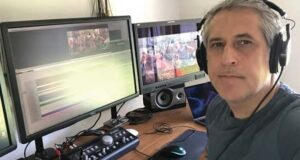
Q What was it like working with the army of artists and technicians who made up the post team?
As the dailies poured in, Jon and I looked to Mark Russell, visual effects supervisor, Tim Donovan, visual effects editor, Skylar Nichols, visual effects coordinator, and the rest of the in-house visual effects team, Coche Gonzales and John Ashby, to help develop our temps.
If we wanted the manhole cover to spin like a record scratch they could create a temp version in a couple of days. If we wanted our split screens to look like sides of the bodega store cans, they could do that too. Our shot of Usnavi rapping with the dancers in the bodega window reflection started with our in-house post team. It was the same as our giant crane shot with dancers at the end of the number.
Even a visual effects light on top of the George Washington Bridge had a subtle visual effect to match to the beat of the clave at the beginning of the film. Our Long Island beach was transformed into the Dominican Republic by adding palm trees and a deeper blue to the water.
Q How did the music shape the editing?
Our music editors, Jim Bruening and Jennifer Dunnington, were great. During the opening number, for example, Jim and Jennifer provided 5.1 mixes we could use in the edit.
They also provided a temp score by pulling apart the stems of the pre-records of the music. They also helped map out how to begin the underscore (which was really the opening song) for the film. Jon and I liked a little musical motif that was at the end of the film that we wanted in the beginning, so they made a temp version for us.
They could then send this to the composers, Alex Lacamoire and Bill Sherman, as a road map for the final version. As the edit of the opening became more refined, Jim and Jennifer provided detailed notes on how to get the picture to match to the music. Some were to help sync, to get a phrase or vocal to match the actors mouth, and others, helped things like how a coffee maker switch could be “tuned” … [to] match the music.
Q In terms of your working methods, did you tend to separate the musical numbers from the rest of the film?
I treated them all like scenes that kept coming in. I did have a tendency to be pretty overwhelmed by the amount of footage that came in with the musical numbers. I would select little sections at a time, work on them, put them away and then work on a smaller scene.
Some of the musical numbers took weeks, or even months, over the course of the entire shoot. The opening took basically from the beginning of the shoot until it was the last thing they shot, with the community chorus.
If Jon wanted me to cut together something very quickly, I could always do that. If I thought we were in trouble and we didn’t get something out of a particular day, I could approach Jon or Alice Brooks, the cinematographer.
For the most part, I just took my time. I really approached every musical number like a scene, every scene like a musical number. What is the best performance? What are the best moments that are going to tell our story dramatically? The lyrics were my dialogue.
Q Like “West Side Story” (1961), the movie has a showstopper right at the beginning with the title sequence.
Jon said we really need to create our visual grammar right now. We’re going to have touches of surrealism and magical realism, so why don’t we spin that manhole cover.
With musicals, people naturally think, once the song starts, you have to keep going. We said, “No, we’re going to jolt you out of that every once in a while.” We’re going to hit the alarm clock or stop the music on the manhole cover. We’re going to have moments where we are going to sit on a reflection of Usnavi at the bodega and you can see the dancers all in one shot.
Q This is not a Fred Astaire or Gene Kelly musical. The frame is dense and packed with bodies and objects. What were the particular challenges of shaping the numbers?
I think a really good example of that is the club scene. The room was so crowded, but there was also a real consistency to the choreography if you looked at it very closely. Every dancer is doing an incredible movement that is synchronized, and you have other dancers who are freestyling.
My trick was to show both without it feeling too frenetic. There were parts where I could sit back and watch two people together, and I could also cut to somebody in a closeup who is freestyling. As long as I don’t make it too quick, I think there is permission to dance around the room a little bit.
Q The “96,000” number is the other tour de force musical number. Did you talk with the choreographers and the cinematographer Alice Brooks? Did you work off the storyboards?
It just depended on certain pieces. The beginning of “In the Heights” had a lot of storyboards and rehearsal footage [from which] I could get an idea of some of the construction. With “96,000,” it was more about best laid plans and perfect weather. It was raining almost every day they shot there. They had to think on their feet a little bit.
When I started to understand the song a little bit more, that it was each of these characters talking about what they’d do with this money, it became easier to tackle. I knew we were going to have sections. I knew we had to do the handoffs elegantly. I had to build that number the way that the song is built. I needed to isolate vocals and understand how each of these characters overlap. In some ways, the visuals did some of the work in telling me what to do. It was really about the song as well.
The water imagery, the stylization, the animation, there is a great deal to pull off there.
I asked my first assistant, Andrew Pang, to provide split-outs of the pre-record isolated vocals. These were helpful to track each of the characters’ stories in the song. I began the process of selecting footage based on each different character’s story. As the song built in energy and layers, Jon and I built the edit to match. In the first section of the musical number, Usnavi, Benny, Sonny, and Graffiti Pete sing live on the street as they head to the pool.
With the exception of Corey Hawkins, who played Benny, I used the actors’ live performance in the assembly, and we tried to keep as much of that as possible. I treated their rap and performance like I was cutting any dialog scene. My main focus wasn’t the song, but how each actor made fun of the other, as they expressed how they would spend their lottery earnings. Then as we entered the pool, I again constructed each individual story like a mini-scene in the same way.
As the choreography and storytelling built, we intercut Graffiti Pete spraying the lottery ticket numbers, and the community chorus singing about their own dreams. The final reveal that no one at the pool had the winning ticket was a funny juxtaposition to the high energy spectacle that we just finished.
Patrick Z. McGavin is a Chicago-based writer and cultural critic.


